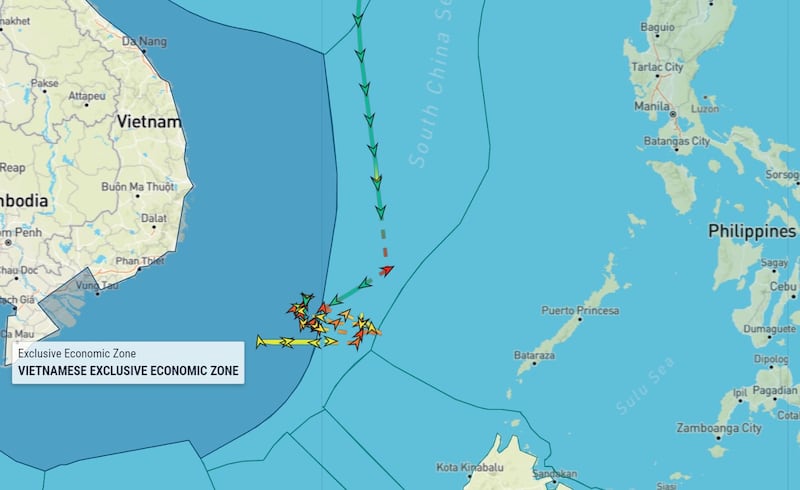After finishing with the Philippines, Chinese maritime militia and fishing boats apparently swarmed inside Vietnam’s exclusive economic zone (EEZ) in the South China Sea, according to a Vietnamese research organization citing vessel-tracking data.
A 2,600-ton Chinese survey vessel, the Haiyang Dizhi Si Hao, had lingered inside Hanoi’s EEZ as well, signaling “a possible operation” there, the South China Sea Chronicle Initiative also reported.
According to the SCSCI, the number of Chinese vessels in the economic zone increased measurably in the first two weeks of March, almost tripling the number observed at the end of February. An EEZ gives a state exclusive access to natural resources in the waters and in the seabed.
The data was collected using automatic identification system (AIS) signals transmitted by the ships.
“The Chinese vessels have also been operating deep inside Vietnam’s EEZ, up to just 60 nautical miles (111km) from the Quang Ngai coast,” Van Pham, SCSCI’s manager, told Radio Free Asia, referring to a province in central Vietnam.
The fishing and militia vessels often are accompanied by the China Coast Guard.
Chinese survey vessel
Meanwhile on Wednesday, the Chinese research and survey ship, also known as the Haiyang Dizhi 4, spent hours in Vietnamese-controlled waters before entering an area of overlapping claims in the South China Sea.
Vietnam, Brunei, Indonesia, Malaysia, the Philippines, Taiwan and China all claim parts of the strategic waterway, but the area claimed by Beijing is by far the largest.
China and neighboring countries have been at loggerheads over Beijing’s oil and gas exploration in the sea.

According to the ship tracker Marine Traffic, the Haiyang Dizhi 4 was in Vietnam’s EEZ for more than 17 hours on March 15.
“It looks like the ship was conducting an operation here,” the SCSCI alleged.
The Vietnamese Foreign Ministry was not immediately available for comment.
Hanoi has repeatedly complained about the activities of Chinese survey vessels in its EEZ, calling them “a violation of Vietnam’s sovereignty.”
In 2019, a protest broke out in front of the Chinese embassy in Hanoi over the Haiyang Dizhi 8, a survey ship which had operated for months in Vietnam-controlled waters.
The next year, the same ship was involved in a month-long standoff with a Malaysian oil exploration vessel.
The biggest confrontation to date between Vietnam and China over oil and gas exploration in the South China Sea was in 2014, when China moved a drilling platform – the Hai Yang Shi You 981 – into Vietnamese waters.
The incident involved dozens of law enforcement ships from both sides and led to anti-China protests in Vietnam.
In the end, China withdrew the oil rig after two and a half months.
Gray zone operations
China has been conducting so-called “gray zone” operations, with nontraditional forces such as maritime militia being used to achieve security and economic objectives.
Another claimant in the South China Sea, the Philippines, recently accused Chinese maritime militia ships of swarming inside its EEZ.
In the latest development, China’s maritime militia ships off the Philippines-controlled Thitu island were scattering after swarming there earlier this month, according to Ray Powell, Project Myoushu (South China Sea) lead at Stanford University in California.
On March 4, the Philippine Coast Guard said over 40 suspected Chinese maritime militia vessels were spotted within 4.5 to 8 nautical miles off the shores of the island, which is known in the Philippines as Pag-asa.
“By periodically dispersing its forces, China’s militia fleet seems intent on making it more difficult for Philippine law enforcement agencies to track and document its swarm tactics,” Powell told RFA.
China’s maritime militia is mostly organized by the country’s large fishing companies.
Research by Andrew Erickson and Conor Kennedy in 2016 found that the only estimate of the size of the Chinese maritime militia was from a source published in 1978, which put the number of personnel at 750,000 on approximately 140,000 vessels. This number has likely grown substantially since.
In its 2010 Defense White Paper, China stated that it had eight million militia members nationwide, including maritime militia.
Edited by Imran Vittachi.

